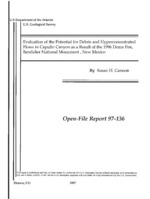The Dome fire of April 1996 burned 6684 ha in Bandelier National Monument and the adjacent Sante Fe National Forest. The potential for significant debris- and hyperconcentrated-flow activity in Capulin Canyon is evaluated through 1) a systematic consideration of geologic and geomorphic factors that characterize the condition of the hillslope materials and channels following the fire, 2) examination of sedimentologic evidence for past debris-flow activity in the canyon, and 3) evaluation of the response of the watershed through the 1996 summer monsoon season. The lack of accumulations of dry-ravel material on the hillslopes or in channels, the absence of a continuous hydrophobic layer, the relatively intact condition of the riparian vegetation and of the fibrous root mat on the hillslopes, and the lack of evidence of widespread past debris- and hyperconcentrated-flow activity, even with evidence of past fires, indicate a low potential for debris-flow activity in Capulin Canyon. In addition, thunderstorms during the summer monsoon of 1996 resulted in abundant surface overland flow on the hillslopes which transported low-density pumice, charcoal, ash and some mineral soil downslope as small-scale and non-erosive debris flows. In some places cobble- and boulder-sized material was moved short distances. A moderate potential for debris- and hyperconcentrated-flow activity is identified for the two major tributary canyons to Capulin Canyon based on evidence of both summer of 1996 and possible historic significant debris-flow activity.


